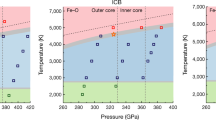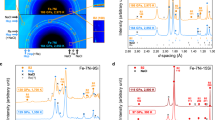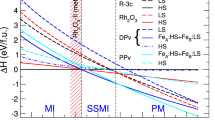Abstract
The nature of the stable phase of iron in the Earth's solid inner core is still highly controversial. Laboratory experiments1 suggest the possibility of an uncharacterized phase transformation in iron at core conditions and seismological observations2,3,4 have indicated the possible presence of complex, inner-core layering. Theoretical studies5,6 currently suggest that the hexagonal close packed (h.c.p.) phase of iron is stable at core pressures and that the body centred cubic (b.c.c.) phase of iron becomes elastically unstable at high pressure. In other h.c.p. metals, however, a high-pressure b.c.c. form has been found to become stabilized at high temperature. We report here a quantum mechanical study of b.c.c.-iron able to model its behaviour at core temperatures as well as pressures, using ab initio molecular dynamics free-energy calculations. We find that b.c.c.-iron indeed becomes entropically stabilized at core temperatures, but in its pure state h.c.p.-iron still remains thermodynamically more favourable. The inner core, however, is not pure iron, and our calculations indicate that the b.c.c. phase will be stabilized with respect to the h.c.p. phase by sulphur or silicon impurities in the core. Consequently, a b.c.c.-structured alloy may be a strong candidate for explaining the observed seismic complexity of the inner core2,3,4.
This is a preview of subscription content, access via your institution
Access options
Subscribe to this journal
Receive 51 print issues and online access
$199.00 per year
only $3.90 per issue
Buy this article
- Purchase on Springer Link
- Instant access to full article PDF
Prices may be subject to local taxes which are calculated during checkout


Similar content being viewed by others
References
Brown, M. J. The equation of state of iron to 450 GPa: Another high-pressure solid phase? Geophys. Res. Lett. 28, 4339–4342 (2001)
Song, X. D. & Helmberger, D. V. Seismic evidence for an inner core transition zone. Science 282, 924–927 (1998)
Beghein, C. & Trampert, J. Robust normal mode constraints on inner-core anisotropy from model space search. Science 299, 552–555 (2003)
Ishii, M. & Dziewonski, A. M. The innermost inner core of the earth: Evidence for a change in anisotropic behavior at the radius of about 300 km. Proc. Natl Acad. Sci. USA 99, 14026–14030 (2002)
Steinle-Neumann, G., Stixrude, L., Cohen, R. E. & Gülseren, O. Elasticity of iron at the temperature of the Earth's inner core. Nature 413, 57–60 (2001)
Vočadlo, L., Brodholt, J., Alfè, D., Gillan, M. J. & Price, G. D. Ab initio free energy calculations on the polymorphs of iron at core conditions. Phys. Earth Planet. Inter. 117, 123–137 (2000)
Shen, G. Y., Mao, H. K., Hemley, R. J., Duffy, T. S. & Rivers, M. L. Melting and crystal structure of iron at high pressures and temperatures. Geophys. Res. Lett. 25, 373–376 (1998)
Ross, M., Young, D. A. & Grover, R. Theory of the iron phase diagram at Earth core conditions. J. Geophys. Res. 95, 21713–21716 (1990)
Matsui, M. & Anderson, O. L. The case for a body-centred-cubic phase (αv) for iron at inner core conditions. Phys. Earth Planet Inter. 103, 55–62 (1997)
Petry, W. Dynamical precursors of martensitic transitions. J. Phys. IV 5, C2-15–C2-28 (1995)
Trampenau, J. et al. Phonon dispersion of the bcc phase of group-IV metals. III. bcc hafnium. Phys. Rev. B 43, 10963–10969 (1991)
Söderlind, P., Moriarty, J. A. & Willis, J. M. First-principles theory of iron up to Earth-core pressures: structural, vibrational and elastic properties. Phys. Rev. B 53, 14063–14072 (1996)
Stixrude, L. & Cohen, R. E. Constraints on the crystalline structure of the inner core: mechanical instability of BCC iron at high pressures. Geophys. Res. Lett. 22, 125–128 (1995)
Moriarty, J. A. in High Pressure Science and Technology 1993 (eds Schmidt, S. C., Shaner, J. W., Samara, G. A. & Ross, M.) 233–236 (AIP Press, New York, 1994)
Mao, H. K. et al. Phonon density of states of iron up to 153 gigapascals. Science 292, 914–916 (2001)
Hohenberg, P. & Kohn, W. Inhomogeneous electron gas. Phys. Rev. 136, B864–B871 (1964)
Wang, Y. & Perdew, J. Correlation hole of the spin-polarized electron gas, with exact small-wave-vector and high-density scaling. Phys. Rev. B 44, 13298–13307 (1991)
Kresse, G. & Furthmüller, J. Efficient iterative schemes for ab initio total-energy calculations using a plane-wave basis set. Phys. Rev. B 54, 11169–11186 (1996)
Blöchl, P. E. Projector augmented-wave method. Phys. Rev. B 50, 17953–17979 (1994)
Alfè, D., Kresse, G. & Gillan, M. J. Structure and dynamics of liquid iron under Earth's core conditions. Phys. Rev. B 61, 132–142 (2000)
Alfè, D., Price, G. D. & Gillan, M. J. Thermodynamics of hexagonal-close-packed iron under Earth's core conditions. Phys. Rev. B 64, 045123 (2001)
Grad, G. B. et al. Electronic structure and chemical bonding effects upon the bcc to Ω phase transition: ab initio study of Y, Zr, Nb and Mo. Phys. Rev. B 62, 12743–12753 (2000)
Alfè, D., Gillan, M. J. & Price, G. D. The melting curve of iron at Earth's core pressures from ab initio calculations. Nature 401, 462–464 (1999)
Alfè, D., Price, G. D. & Gillan, M. J. Iron under Earth's core conditions: liquid-state thermodynamics and high pressure melting curve from ab initio calculations. Phys. Rev. B 65, 165118 (2002)
Vočadlo, L. & Alfè, D. Ab initio melting curve of the fcc phase of aluminium. Phys. Rev. B 65, 214105 (2002)
Lin, J.-F., Heinz, D. L., Campbell, A. J., Devine, J. M. & Shen, G. Iron-silicon alloy in Earth's core? Science 295, 313–315 (2002)
Alfè, D., Price, G. D. & Gillan, M. J. Composition and temperature of the Earth's core constrained by combining ab initio calculations and seismic data. Earth Planet. Sci. Lett. 195, 91–98 (2002)
Alfè, D., Price, G. D. & Gillan, M. J. Ab initio chemical potentials of solid and liquid solutions and the chemistry of the Earth's core. J. Chem. Phys. 116, 7127–7136 (2002)
Alfè, D., Gillan, M. J. & Price, G. D. Constraints on the composition of the Earth's core from ab-initio calculations. Nature 405, 172–175 (2000)
Dobson, D. P., Vočadlo, L. & Wood, I. G. A new high-pressure phase of FeSi. Am. Mineral. 87, 784–787 (2002)
Acknowledgements
L.V. and D.A. thank the Royal Society for their continued support through the University Fellowship scheme. We also thank NERC for providing computing facilities via grants.
Author information
Authors and Affiliations
Corresponding author
Ethics declarations
Competing interests
The authors declare that they have no competing financial interests.
Rights and permissions
About this article
Cite this article
Vočadlo, L., Alfè, D., Gillan, M. et al. Possible thermal and chemical stabilization of body-centred-cubic iron in the Earth's core. Nature 424, 536–539 (2003). https://doi.org/10.1038/nature01829
Received:
Accepted:
Issue Date:
DOI: https://doi.org/10.1038/nature01829
This article is cited by
-
Accelerating the prediction of stable materials with machine learning
Nature Computational Science (2023)
-
An estimate of absolute shear-wave speed in the Earth’s inner core
Nature Communications (2023)
-
Crystal structure prediction at finite temperatures
npj Computational Materials (2023)
-
High-accuracy thermodynamic properties to the melting point from ab initio calculations aided by machine-learning potentials
npj Computational Materials (2023)
-
Two-phase mixture of iron–nickel–silicon alloys in the Earth’s inner core
Communications Earth & Environment (2021)
Comments
By submitting a comment you agree to abide by our Terms and Community Guidelines. If you find something abusive or that does not comply with our terms or guidelines please flag it as inappropriate.



